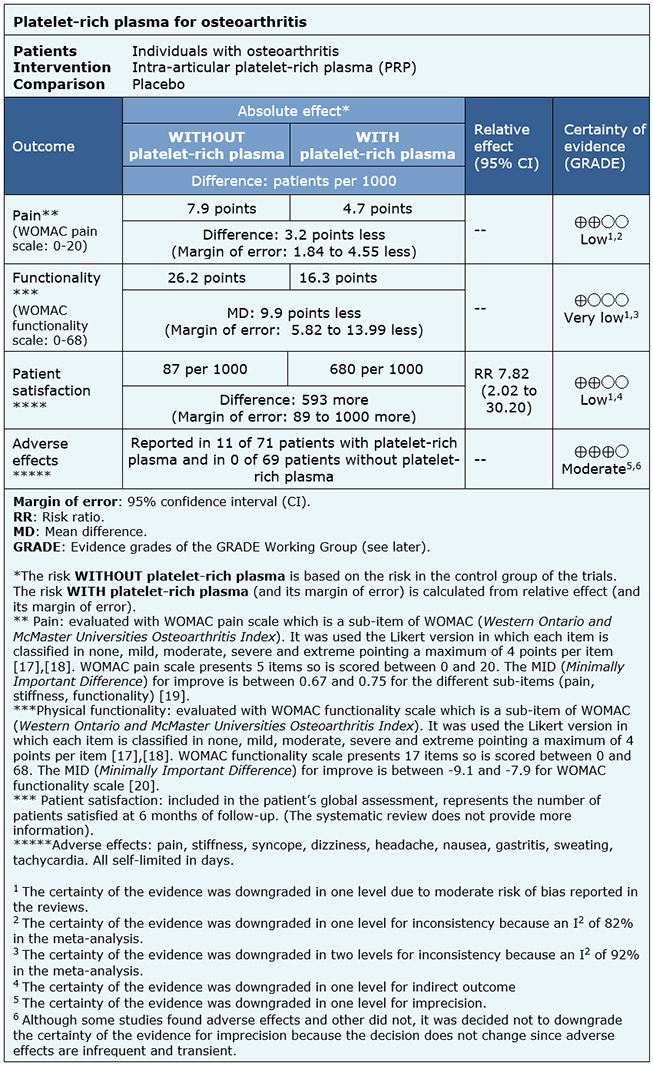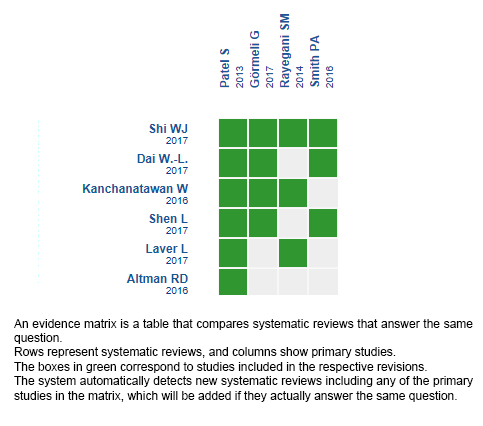Epistemonikos summaries
← vista completaPublished on June 25, 2018 | http://doi.org/10.5867/medwave.2018.03.7216
Is platelet-rich plasma effective for osteoarthritis?
¿Es efectivo el plasma rico en plaquetas para el tratamiento de la artrosis?
Abstract
INTRODUCTION Despite varied non-surgical alternatives for the treatment of osteoarthritis, many patients remain symptomatic. In the last decade, the use of intra-articular platelet-rich plasma (PRP) has been proposed as an option. However, there is controversy about its clinical benefit and safety.
METHODS To answer this question we used Epistemonikos, the largest database of systematic reviews in health, which is maintained by screening multiple information sources, including MEDLINE, EMBASE, Cochrane, among others. We extracted data from the systematic reviews, reanalyzed data of primary studies, conducted a meta-analysis and generated a summary of findings table using the GRADE approach.
CONCLUSIONS We identified twelve systematic reviews including four studies overall, of which all corresponded to randomized trials. We concluded that intra-articular injection of platelet-rich plasma might slightly decrease joint pain and improve patient satisfaction,vut it is not clear whether it has any effect on functionality because the certainty of the evidence is very low. As for the adverse effects, if they exist, they would be non-severe and self-limited.
Problem
Osteoarthritis is a highly prevalent condition and an important cause of consultation in both primary and secondary care. The persistence of its symptoms, particularly pain, leads patients to repeated consultation, generally looking for non-surgical alternatives.Platelet-rich plasma is a blood product prepared through the centrifugation of autologous blood to increase the concentration of platelets and therefore the level of growth factors. The regenerative and anti-inflammatory potential of platelet-rich plasma is being studied in multiple musculoskeletal conditions, including osteoarthritis. Additionally, adverse effects would be mild, mainly secondary to arthrocentesis. However, the costs associated to this intervention are substantial, so it is important to have a clear estimation of benefits and harms.
Methods
To answer the question, we used Epistemonikos, the largest database of systematic reviews in health, which is maintained by screening multiple information sources, including MEDLINE, EMBASE, Cochrane, among others, to identify systematic reviews and their included primary studies. We extracted data from the identified reviews and reanalyzed data from primary studies included in those reviews. With this information, we generated a structured summary denominated FRISBEE (Friendly Summary of Body of Evidence using Epistemonikos) using a pre-established format, which includes key messages, a summary of the body of evidence (presented as an evidence matrix in Epistemonikos), meta-analysis of the total of studies when it is possible, a summary of findings table following the GRADE approach and a table of other considerations for decision-making.
|
Key messages
|
About the body of evidence for this question
|
What is the evidence. |
We found twelve systematic reviews [1],[2],[3],[4],[5], [6],[7],[8],[9],[10], [11],[12] that included four primary studies [13],[14],[15], [16], all corresponding to randomized trials. |
|
What types of patients were included* |
All of the trials focused on osteoarthritis of the knee. Average age of patients ranged between 50.1 and 56.4 years [13],[14],[15], [16]. The proportion of women was between 55.1 and 93.5 in the different trials. |
|
What types of interventions were included* |
The number of platelet-rich plasma injections was one or two [13], two [14] and three [15],[16]. The volume injected in each trial was 5 ml [16], 4 to 6 ml [14], between 3 to 8 ml [15] and 8 ml [13]. The platelet activating agent was calcium chloride in two trials [13],[16] and none in the rest of the trials [14], [15]. The platelet-rich plasma was centrifuged once [13], [15] or twice [14], [16]. The leukocyte concentration of the platelet-rich plasma was poor in two trials [13],[15] and rich in the other two [14],[16], depending on the concentration of leukocytes in the blood of the patient. All of the trials compared against placebo. Three of them used saline as placebo [13],[15,[16] and the fourth did not use intra-articular injections in the control group. |
|
What types of outcomes |
The outcomes reported in the systematic reviews were pain (measured with WOMAC pain scale) [4],[5],[6],[10],[12], functionality (measured with WOMAC function scale) [4],[5],[6],[10], total WOMAC [3],[5],[6],[8],[10], patient satisfaction [5],[8] and adverse effects [3],[4],[5],[6],[10]. Follow-up was 6 months in three trials [13],[14],[16] and 12 months in one trial[15]. |
* The information about primary studies is extracted from the systematic reviews identified, unless otherwise specified.
Summary of Findings
The information on the effects of platelet-rich plasma was based on three randomized trials that included 140 participants [13],[14],[15]. One trial did not contribute to the meta-analysis [16].
All the trials measured the outcomes pain (WOMAC), functionality (WOMAC) and adverse effects. Only one trial [13] reported patient satisfaction (48 participants).
The summary of findings is as follows:
- Intra-articular injection of platelet-rich plasma might slightly decrease joint pain in patients with osteoarthritis, but the certainty of the evidence is low.
- It is not clear whether an intra-articular injection of platelet-rich plasma improves knee functionality because the certainty of the evidence is very low.
- Intra-articular injection of platelet-rich plasma probably improves patient satisfaction. The certainty of the evidence is low.
- Most patients probably do not experience adverse effects, and if they present them, these are not severe, self-limited and directly related to the number of intra-articular injections. The certainty of this evidence is moderate.


Other considerations for decision-making
|
To whom this evidence does and does not apply |
|
| About the outcomes included in this summary |
|
| Balance between benefits and risks, and certainty of the evidence |
|
| Resource considerations |
|
| What would patients and their doctors think about this intervention |
|
|
Differences between this summary and other sources |
|
| Could this evidence change in the future? |
|
How we conducted this summary
Using automated and collaborative means, we compiled all the relevant evidence for the question of interest and we present it as a matrix of evidence.

Follow the link to access the interactive version: Platelet-rich plasma versus placebo for osteoarthritis
Notes
The upper portion of the matrix of evidence will display a warning of “new evidence” if new systematic reviews are published after the publication of this summary. Even though the project considers the periodical update of these summaries, users are invited to comment in Medwave or to contact the authors through email if they find new evidence and the summary should be updated earlier.
After creating an account in Epistemonikos, users will be able to save the matrixes and to receive automated notifications any time new evidence potentially relevant for the question appears.
This article is part of the Epistemonikos Evidence Synthesis project. It is elaborated with a pre-established methodology, following rigorous methodological standards and internal peer review process. Each of these articles corresponds to a summary, denominated FRISBEE (Friendly Summary of Body of Evidence using Epistemonikos), whose main objective is to synthesize the body of evidence for a specific question, with a friendly format to clinical professionals. Its main resources are based on the evidence matrix of Epistemonikos and analysis of results using GRADE methodology. Further details of the methods for developing this FRISBEE are described here (http://dx.doi.org/10.5867/medwave.2014.06.5997)
Epistemonikos foundation is a non-for-profit organization aiming to bring information closer to health decision-makers with technology. Its main development is Epistemonikos database (www.epistemonikos.org).
Potential conflicts of interest
The authors do not have relevant interests to declare.

